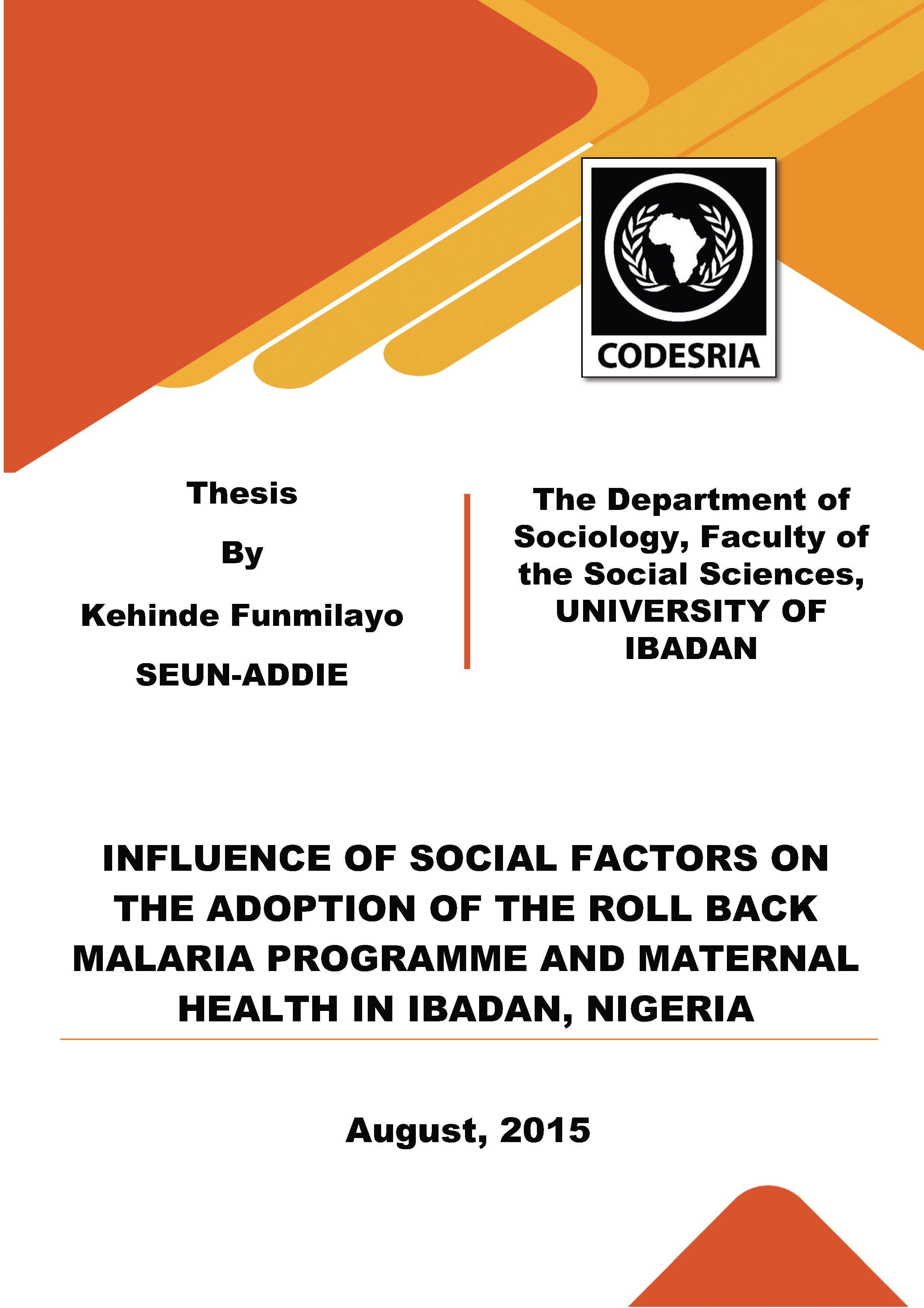INFLUENCE OF SOCIAL FACTORS ON THE ADOPTION OF THE ROLL BACK MALARIA PROGRAMME AND MATERNAL HEALTH IN IBADAN, NIGERIA
Keywords:
Maternal mortality, Roll back malaria programme, Social factors, Ibadan NigeriaSynopsis
Malaria contributes substantially to maternal mortality in Nigeria, especially in Ibadan, which is a holo-endemic area. Despite the introduction of the Roll Back Malaria (RBM) programme, evidence shows that the incidences of maternal mortality due to malaria persist.
Most studies on malaria have focused on preventive behaviour related to environmental and hygiene practices; however little attention has paid to how social factors influence adequate treatment procedure, case management and use of insecticide treated nets (ITNs), which are components of the RBM initiative, particularly during pregnancy. This study, therefore, examined the influence of social factors such as education, marital status and income on the adoption of the RBM programme.
Social Action theory and Health Belief Model were employed as frameworks. The study adopted a cross sectional survey design using multistage sampling technique. Six health centres (one in each local government areas where the RBM programme is prominent) were purposively selected. A semi-structured questionnaire on background characteristics, knowledge, acceptability and adherence to RBM programme were administered to 407 pregnant women based on attendance records in the health centres. Knowledge of malaria, Acceptability of RBM and Adherence to RBM scales were used for data collection. In-depth interviews were also conducted with 13 RBM staff and 24 pregnant women based on records of malaria incidence. Quantitative data were analysed using descriptive statistics, Chi-square and Logistic regression tests at p ≤ 0.05, while qualitative data were content analysed.
The age of respondents was 27.9±5.1 years, 79.0% had post-primary education, mean monthly income was N8,519:34K, 74.0% were self-employed and 59.2% were primigravidae. Although the respondents did not identify RBM as a distinct programme, their knowledge of malaria (χ2 = 21.58) significantly influenced their adoption of RBM programme; decision making (χ2 = 23.03); and use of ITNs (χ2 = 10.95). There was a significant relationship between knowledge of RBM programme and maternal health (β = 0.22). A unit increase in the knowledge of RBM caused 0.8 unit improvement in maternal health. There was a strong relationship between the acceptability of RBM program and maternal health (β = 0.15); a unit increase in the acceptability of the RBM strategy led to 0.86 unit improvement in maternal health. Respondents’ marital status (χ2 = 16.82), monthly income (χ2 = 7.04) and parity (χ2 = 16.39) significantly influenced their adherence to RBM programme, while religion, education, and occupation were not significant. Late registration for Antenatal Clinic made strict adherence to RBM programme difficult; inadequate supply of ITNs, drugs and manpower were major limitations to the effective implementation of the programme.
Social factors largely influenced the adoption of the Roll Back Malaria programme among pregnant women in Ibadan. Increased awareness of the programme and empowerment of women of childbearing age, as well as availability of sufficient tools and services in order to significantly reduce the incidence of malaria are of utmost importance.
Downloads
References
Onyenechere , Emmanuella Chinenye. 2011. Spatial distribution of women informal economic activities in the rural areas of Imo State, Nigeria. Journal of Geography and Regional Planning Vol. 4(1), pp. 20-35, January 2011
Owolabi Babalola 2009. “Counting malaria out, are you involved”. Speech delivered by the Commissioner for Health, Oyo State Ministry of Health. April, 25, 2009: World Malaria Day. PAI. 2007; A measure of survival; calculating women’s sexual and reproductive risk, PAI report card 2007
Philips-Howard PA & Wood D. 1996. The safety of antimalaria drugs in pregnancy. Drug Safety; 14:131-145.
Pluess B, Tanser F.C, Lengeler C, Sharp B.L 2010. Indoor residual praying for preventing malaria. Cochrane Database Syst Rev CD006657.
Ranson H, N’Guessan R, Lines J, Moiroux N, Nkuni Z, Corbel V.2011 Pyrethroid resistance in African anopheline mosquitoes: What are the implications for malaria control? Trends Parasitol 27: 91-8. RBM/WHO/UNICEF, 2005. World malaria report 2005. Http//rbm.who.int/wmr2005/pdf/WMReport IR.pdf.
Ruebush T, Kern M, Campbell C, Oloo A, 1995. Self treatment of malaria in a rural area of western Kenya. Bull World Health Organ 73: 229–236.
Sachs J, and Malaney P. 2002. The economic and social burden of malaria. Nature 415: 680–685.
Schlman C.E; Dorman E.K ; Talisuna A.O ; Lowe B.S; Nevill C; Snow R.W; Jilo H; Peshu N; Bulmer JN; Graham S & Marsh K. 1998. A community randomized controlled trial of insecticide-treated bednets for the prevention of malaria and anemia among primigravidae women on the Kenyan coast. Tropical Medicine and International Health; 3:197-204.
Schultz LJ; Steketee RW; Macheso A; Kazembe P; Chitsulo L & Wirima J. 1994. The efficacy of antimalarial regimens containing sulphadoxine-pyrimethamine and/or chloroquine in preventing peripheral and placental plasmodium falciparum infection among pregnant women in Malawi. American Journal of Tropical Medicine and Hygiene; 51:515-522.
Sharmila N and Albert Christopher Dhas. 2010. Development of Women Education in India. MPRA Paper No. 20680, posted 16. February 2010 00:35 UTC. Online at http://mpra.ub.uni-muenchen.de/20680/. Accessed 3rd July 2015.
Shepherd J, Rowan C, Powell E. 2004. Confirming pregnancy and care of the pregnant woman. Mayes' midwifery. Henderson C, McDonald S. Eds. 13th ed. London: Bailliere Tindall, 235-87.
Shepherd Nyaruwata1 and Leonorah Tendayi Nyaruwata. 2013. Gender equity and executive management in tourism: Challenges in the Southern African Development Community (SADC) region. Afr. J. Bus. Manage Vol. 7(21), pp. 2059-2070, 7 Jun, 2013. DOI: 10.5897/AJBM2013.1592
Shulman C.E; Dorman E.K; Cutts F; Kawuondo K; Bulmer J.N; Peshu N & Marsh K. 1999. Intermittent sulfadoxine-pyrimethamine to prevent severe anaemia secondary to malaria in pregnancy: a andomized placebo-controlled trial. Lance; 353: 632-636






